Originally published at Agroforestry World Blog in 2 parts (here part 2)

The new global agenda has one goal: a sustainable Earth. The contribution of agroforestry in achieving this was discussed in detail at Asia-Pacific Forestry Week (APFW), FTA Flagship 3 coordinator Meine van Noordwijk led the charge. This blog by Rob Finlayson gives an account of his presentation and how well his arguments resonated with experts at the conference. The blog was shortened and edited for the FTA website.
‘All the Sustainable Development Goals (SDGs) are interconnected; we can’t achieve one without the others,’ says Meine van Noordwijk, chief science advisor with the World Agroforestry Centre (ICRAF) and coordinator of the landscapes Flagship of the CGIAR Research Program on Forests, Trees and Agroforestry (FTA).
He divides the SDGs into six groups and argues that agroforestry relates to all of them:
- Agroforestry clearly contributes to the SDGs around poverty reduction (SDG 1) and economic growth (SDG 8) through provision of income from tree products;
- For the SDGs on zero hunger (2), good health and well-being (3) and responsible consumption and production (12) agroforestry is very relevant through the provision of nutritious food and all the other benefits that trees can bring to a household;
- Clean water and sanitation (6) and life below water (14) link to healthy, agroforested watersheds and coastal agroforests, including mangroves;
- Affordable and clean energy (7), industry, innovation and infrastructure (9) and sustainable cities and communities (11) need trees as sources of bioenergy, including by-products from fruit and shade trees. Green cities can be cooled down by trees.
- Of course trees feature critically for SDGs 13, keeping climate change in check and 15, conserving biodiversity;
- The other SDGs (dealing with issues such as conflict, equity, transparency and gender), relate to the so-called ‘soft’ side of agroforestry, which is about people and their interactions with each other and the environment.
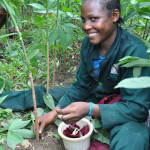
To achieve the SDGs, ‘we need to combine knowledge systems’, explains van Noordwijk: Knowledge can not only come from science, but also has to stem from local and indigenous sources, from the public sector and policy makers, and many others.
‘We need to understand how knowledge is created in each of these arenas and how to use these experiences to change the trajectory our world has been on,’ says van Noordwijk.
Many different types of agroforestry can already be seen around the world: the mechanised row-cropping favoured in the European Union, swidden systems in tropical forests, rice fields surrounded by planted fruit and timber trees.
‘There is no single way to define agroforestry other than: it is the interface between farmers and forests,’ he adds.
How agroforestry can help the SDGs
- To meet the SDGs, land productivity in both agriculture and forestry will have to increase. Agroforestry is one of the most efficient ways of using land. As a land-use system in-between forest and open-field agriculture, it can—with appropriate combinations of trees, crops and livestock—provide a range of goods, benefits and services simultaneously, such as nutritious food, renewable energy and clean water while conserving biodiversity. Efficient, multifunctional land use, such as agroforestry, supports ‘sustainable intensification’.
- Segregating forest land from agrarian communities leads to conflicts that reduce land productivity and increase inequity. Agroforestry needs to become an institutional response to contested resources, allowing enhancement of gender and social equity. There is no valid method of drawing a line between agriculture and forestry. The only validity is ‘agro + forestry’.
- Development challenges are in part the result of the sectoral approach that dominates government systems, with the various SDGs attributable to separate conventions and ministries. Agroforestry as an integrated mindset can help create synergy between the SDGs in multifunctional landscapes, breaking out of the artificially-constructed institutional silos.
Expert from various countries of the region responded positively to Meine van Noordwijk’s arguments.
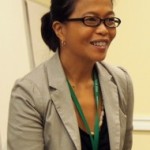 Imelda Bacudo of the Association of Southeast Asian Nations (ASEAN)-German Programme on Response to Climate Change in Agriculture and Forestry said it was hard to see the desired convergence of forestry and agriculture, yet this was something that was much needed.
Imelda Bacudo of the Association of Southeast Asian Nations (ASEAN)-German Programme on Response to Climate Change in Agriculture and Forestry said it was hard to see the desired convergence of forestry and agriculture, yet this was something that was much needed.
‘We have to move forward on how to merge them’, she urged. ‘What’s preventing us from doing this is that we are challenged by administrative borders. Throughout the region, ministries of agriculture and of forestry are divided or if they are in one ministry they are divided within. We need to address this problem. It’s the biggest challenge we face.’
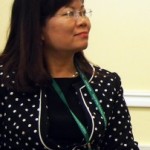 Nguyen Tuong Van of VNFOREST, Viet Nam, agreed: ‘There are many links between agroforestry and the Sustainable Development Goals and Viet Nam already has a lot of agroforestry models.
Nguyen Tuong Van of VNFOREST, Viet Nam, agreed: ‘There are many links between agroforestry and the Sustainable Development Goals and Viet Nam already has a lot of agroforestry models.
But agroforestry still falls between forestry and agriculture. Even though in Viet Nam we have one ministry, the sectors are two different departments and neither takes care of agroforestry. We need to combine these.
But negotiating between departments even in one ministry is a big problem. ICRAF can support countries to do this. Agroforestry should be under one institution. This is important for attracting investment and driving action.’
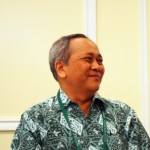 The same case applies in Indonesia, said Wiratno, Director of Social Forestry Land Preparation of the Indonesian Ministry of Environment and Forestry and chairperson of the ASEAN Social Forestry Network secretariat.
The same case applies in Indonesia, said Wiratno, Director of Social Forestry Land Preparation of the Indonesian Ministry of Environment and Forestry and chairperson of the ASEAN Social Forestry Network secretariat.
‘Sectoral egoism is very big. This is our common challenge. We have an agroforestry program in which we have to support 50,000 ha every year and also deliver state forests to local communities,’ he said, referring to the government program of allocating 5.5 million hectares of forest to local people within the next four years towards a total of 12.7 million hectares by 2020.
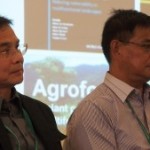
According to Hendri Binahon, a Philippine farmer and successful practitioner of agroforestry, the greatest challenge is ‘changing the mindset of farmers, extensionists, government officials, policy makers and then we can have agroforestry in most of the landscapes in tropical countries’.
Rex Cruz of the University of the Philippines at Los Baños, thinks that van Noordwijk’s arguments cannot be contested in the face of a growing population and increasing development: ‘It is inevitable we will change the natural face of our landscape. The only question is how far do we want to change it and how can we use agroforestry as a strategy to generate the types of goods and services we demand from the land.’
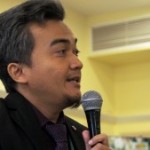 Dian Sukmajaya of the ASEAN Economic Community Department of the ASEAN Secretariat called on policy makers to change their mindset – and policies in order to overcome landscape segregation. ‘Agroforestry has been practiced for thousands of years, contributes directly to SDG 17 and others, and offers efficient use of land.’
Dian Sukmajaya of the ASEAN Economic Community Department of the ASEAN Secretariat called on policy makers to change their mindset – and policies in order to overcome landscape segregation. ‘Agroforestry has been practiced for thousands of years, contributes directly to SDG 17 and others, and offers efficient use of land.’
Photos of experts at APFW by Rob Finlayson











